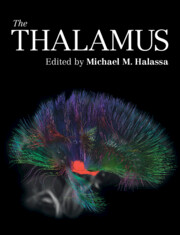Book contents
- The Thalamus
- The Thalamus
- Copyright page
- Contents
- Contributors
- Preface
- Section 1: History
- Section 2: Anatomy
- Section 3: Evolution
- Section 4: Development
- Section 5: Sensory Processing
- Chapter 9 Thalamocortical Interactions in the Primary Visual Cortex
- Chapter 10 Corticothalamic Feedback in Vision
- Chapter 11 The Vibrissa Sensorimotor System of Rodents: A View from the Sensory Thalamus
- Chapter 12 Corticothalamic Pathways in the Somatosensory System
- Chapter 13 Thalamocortical Circuits for Auditory Processing, Plasticity, and Perception
- Section 6: Motor Control
- Section 7: Cognition
- Section 8: Arousal
- Section 9: Computation
- Index
- References
Chapter 9 - Thalamocortical Interactions in the Primary Visual Cortex
from Section 5: - Sensory Processing
Published online by Cambridge University Press: 12 August 2022
- The Thalamus
- The Thalamus
- Copyright page
- Contents
- Contributors
- Preface
- Section 1: History
- Section 2: Anatomy
- Section 3: Evolution
- Section 4: Development
- Section 5: Sensory Processing
- Chapter 9 Thalamocortical Interactions in the Primary Visual Cortex
- Chapter 10 Corticothalamic Feedback in Vision
- Chapter 11 The Vibrissa Sensorimotor System of Rodents: A View from the Sensory Thalamus
- Chapter 12 Corticothalamic Pathways in the Somatosensory System
- Chapter 13 Thalamocortical Circuits for Auditory Processing, Plasticity, and Perception
- Section 6: Motor Control
- Section 7: Cognition
- Section 8: Arousal
- Section 9: Computation
- Index
- References
Summary
Sensory information enters the cerebral cortex through separate thalamocortical pathways that originate in different senses. One of these pathways links the dorsal lateral geniculate nucleus of the thalamus to the primary visual cortex and is crucial for mammalian vision. Over the past decades, there has been tremendous progress in understanding its functional organization, and new tools are allowing us to isolate, with increasing precision, its different components. Just as different senses remain segregated on their way to the cerebral cortex, the different properties of the visual stimulus also reach the primary visual cortex through separate geniculocortical pathways. On the one hand, these separate pathways underlie the parallel processing of stimulus position, eye of origin, light–dark polarity, and temporal dynamics, a strategy that is well preserved across species. On the other hand, the convergence of the different geniculocortical pathways in the visual cortex enables cortical neurons to extract features of the visual world that are not encoded by any geniculocortical pathway individually. This chapter reviews the current knowledge on the functional organization of this prominent thalamocortical pathway and concludes by raising key questions to be addressed in the future.
Keywords
- Type
- Chapter
- Information
- The Thalamus , pp. 187 - 205Publisher: Cambridge University PressPrint publication year: 2022

